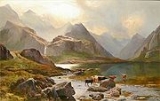
Loch Coruisk
Encyclopedia
Loch Coruisk is an inland fresh-water loch
, lying at the foot of the Black Cuillin
in the Isle of Skye, in the Scottish Highlands
.
, or on foot from Sligachan
(approximately 7–8 miles’ distance). It is also possible to walk from Elgol, but one section of the path (“the Bad Step”) presents some potential difficulties for the nervous or inexperienced.
The northern end of the loch is ringed by the Black Cuillin, often wreathed in cloud. From the southern end a small rivulet, approximately 250 yards long, discharges into a sea loch, Loch Scavaig. The loch is nearly two miles long, but only a couple of hundred yards wide.
visited the loch in 1814 and described it vividly:
Lord Tennyson
reported more prosaically:
Mark Haddon
used the remote location of the loch for a portal
in the 1992 children's novel Gridzbi Spudvetch!, re-issued in 2009 as Boom!
. A description of the path from Elgol (including a traverse
of The Bad Step) is included in the narrative, as is the Memorial Hut.
(1769–1837), J.M.W. Turner (1775–1851), Sidney Richard Percy
(1821–1886) and Alexander Francis Lydon
(1836–1917)
Loch
Loch is the Irish and Scottish Gaelic word for a lake or a sea inlet. It has been anglicised as lough, although this is pronounced the same way as loch. Some lochs could also be called a firth, fjord, estuary, strait or bay...
, lying at the foot of the Black Cuillin
Cuillin
This article is about the Cuillin of Skye. See Rùm for the Cuillin of Rùm.The Cuillin are a range of rocky mountains located on the Isle of Skye in Scotland. The true Cuillin are also known as the Black Cuillin to distinguish them from the Red Hills across Glen Sligachan...
in the Isle of Skye, in the Scottish Highlands
Scottish Highlands
The Highlands is an historic region of Scotland. The area is sometimes referred to as the "Scottish Highlands". It was culturally distinguishable from the Lowlands from the later Middle Ages into the modern period, when Lowland Scots replaced Scottish Gaelic throughout most of the Lowlands...
.
Geography
The loch is accessible by boat from ElgolElgol
Elgol is a village on the shores of Loch Scavaig towards the end of the Strathaird peninsula in the Isle of Skye, in the Scottish Highlands.-Name:...
, or on foot from Sligachan
Sligachan
Sligachan is a small settlement on Skye, Scotland. It is close to the Cuillin mountains and provides a good viewpoint for seeing the Black Cuillin mountains.-Amenities:...
(approximately 7–8 miles’ distance). It is also possible to walk from Elgol, but one section of the path (“the Bad Step”) presents some potential difficulties for the nervous or inexperienced.
The northern end of the loch is ringed by the Black Cuillin, often wreathed in cloud. From the southern end a small rivulet, approximately 250 yards long, discharges into a sea loch, Loch Scavaig. The loch is nearly two miles long, but only a couple of hundred yards wide.
Literature
Sir Walter ScottWalter Scott
Sir Walter Scott, 1st Baronet was a Scottish historical novelist, playwright, and poet, popular throughout much of the world during his time....
visited the loch in 1814 and described it vividly:
- “Rarely human eye has known
- A scene so stern as that dread lake,
- With its dark ledge of barren stone...”
Lord Tennyson
Alfred Tennyson, 1st Baron Tennyson
Alfred Tennyson, 1st Baron Tennyson, FRS was Poet Laureate of the United Kingdom during much of Queen Victoria's reign and remains one of the most popular poets in the English language....
reported more prosaically:
- “Loch Coruisk, said to be the wildest scene in the Highlands, I failed in seeing. After a fatiguing expedition over the roughest ground on a wet day we arrived at the banks of the loch, and made acquaintance with the extremest tiptoes of the hills, all else being thick wool-white fog.”
Mark Haddon
Mark Haddon
Mark Haddon is an English novelist and poet, best known for his 2003 novel The Curious Incident of the Dog in the Night-Time.- Life and work :...
used the remote location of the loch for a portal
Portals in fiction
A portal in science fiction and fantasy is a magical or technological doorway that connects two distant locations separated by spacetime. It usually consists of two or more gateways, with an object entering one gateway leaving via the other instantaneously....
in the 1992 children's novel Gridzbi Spudvetch!, re-issued in 2009 as Boom!
Boom! (novel)
Boom! is a children's science fiction novel by Mark Haddon published in 2009. It is the revised version of Mark Haddon's Gridzbi Spudvetch!, which was published in 1992.-Plot summary:...
. A description of the path from Elgol (including a traverse
Traverse (climbing)
A traverse is a lateral move or route when climbing; going mainly sideways rather than up or down. Traversing a climbing wall is a good warm-up exercise....
of The Bad Step) is included in the narrative, as is the Memorial Hut.
Art
The loch has been painted by, among many others, William DaniellWilliam Daniell
William Daniell RA was an English landscape and marine painter, and engraver. He travelled extensively in the Far East, helping to produce one of the finest illustrated volumes of the period - "Oriental Scenery". He also travelled around the coastline of Britain to paint watercolours for the...
(1769–1837), J.M.W. Turner (1775–1851), Sidney Richard Percy
Sidney Richard Percy
Sidney Richard Percy , born Sidney Richard Percy Williams, was an English landscape painter.-Biography:...
(1821–1886) and Alexander Francis Lydon
Alexander Francis Lydon
Alexander Francis Lydon was an English watercolour artist, illustrator and engraver of natural history and landscapes. He worked for Benjamin Fawcett the printer, to whom he had been apprenticed from an early age. He collaborated on a large number of works with the Rev...
(1836–1917)

